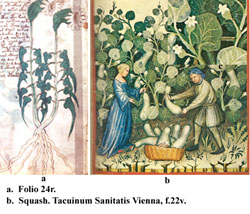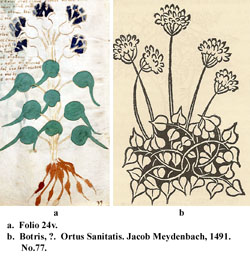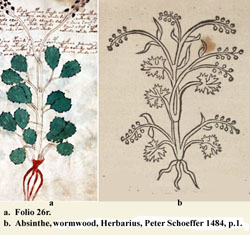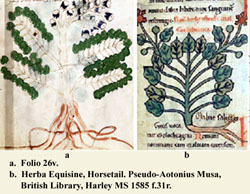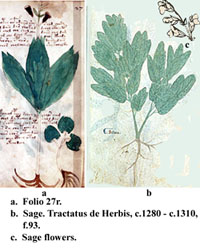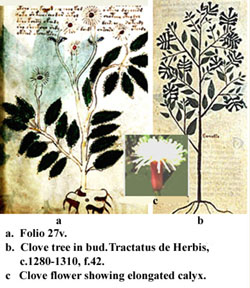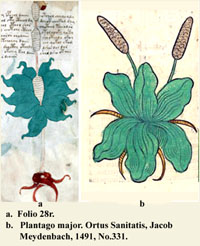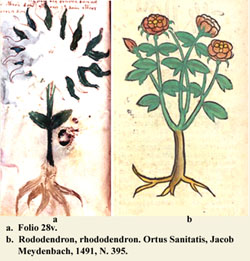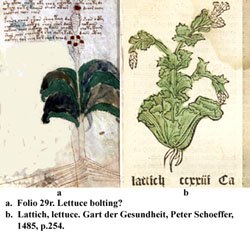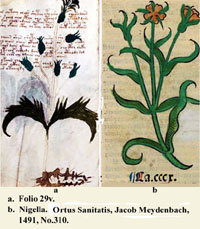The Voynich Botanical Plants
Folio 24r. Squash. A species in the genus Cucurbita. The cucumber is also a member of this family, so this folio may equally represent a cucumber vine. Cucumbers have been cultivated for at least 3,000 years. The Romans were very partial to the fruit and are reported to have used cucumbers to treat scorpion bites, bad eyesight, and to scare away mice. (1) (B)
Folio 24v. Botris. No plant is known by this name. (B)
Folio 26r. Wormwood (Artemesia absinthium). “The juice of the bitter woodworm mingled with sweet mulk is good for the worms in the womb and for the worms in a man’s ears,” states Bancker’s Herbal. “When drunk with Spicknard it assuages the wicked winds of the stomach. Pounded with the gall of bull, and there after put into a man’s eyes, it putteth away all manner of impediments of the sight. It is good to comfort the heart.” (2) (B)
Folio 26v. Horsetail (Equisetum). The plant depicted in these two illustrations does not look much like the plant we know today as horsetail. (B)
Folio 27r Meadow sage (Salvia pratensis). Sage, as the name implies, caries the power of wisdom and longevity and has the reputation of restoring the memory in elderly people. Sage tea with vinegar was used during the plague. After an outbreak women were forced to drink sage juice to make them more fertile. Sage was a cure all for many complaints. (B)
Folio 27v. Clove (Syzyglum aromaticum). Cloves are native to the Maluku islands in Indonesia. The flower buds from this tree are used as a spice; Oil of cloves is used in some toothpastes, laxative pills and as a local anesthetic. In the 3rd century BC, a Chinese leader required visitors to chew cloves to freshen their breath. In the Middle Ages, Muslim sailors traded cloves. Ibu Battuta (1304 1368) a Moroccan explorer who visited Eastern Europe, mentions the clove trade and Sinbad the Sailor is known to have bought and sold cloves. (1) (B)
Folio 28r. Plantago major was an important medical crop. A poultice of its leaves when applied to a wound, sting or sore helped healing and prevented infection. A tea made from its leaves was used to treat diarrhea. Its leaves are rich in calcium and vitamins A, C and K. the young leaves may be eaten raw and the older ones cooked in soups and stews. (1) (B)
Folio 28v.B Rhododendron. Some rhododendron species are extremely toxic to grazing animals, particularly horses. The Greek soldier Xenophon, (431 to 355 BC), noted that some of his soldiers became ill after eating honey made from the nectar of rhododendron flowers. Pompey’s soldiers, in 67 BC, reportedly suffered lethal casualties from eating honey from a similar source. Rhododendrons produce a toxin that has a slightly hallucinogenic and laxative effect on humans. (1) (B)
Folio 29r. Lettuce (Lactuce sativa). The Egyptians and the Romans considered lettuce to be a symbol of sexual prowess, but the Greeks connected the plant with male impotency. When the stem of lettuce is cut a white liquid is extruded, lettuce opium, which has mild narcotic properties. Lettuce extracts are sometimes used n skin creams and for treating sun burns. (1) (B)
Folio 29v. Roman coriander (Nigella sativa), is an annual plant in the ranunculaceae family, native to Southern Europe, North Africa, and Southwest Asia. The fruit is a balloon-like capsule containing numerous seeds that are frequently referred to as black cumin and are used in Asian and Middle Eastern cooking. Muslim tradition claims that these seeds are a cure for all ailments except death. The seeds contain two toxic substances so this spice should be used in moderation. (1) (B)
